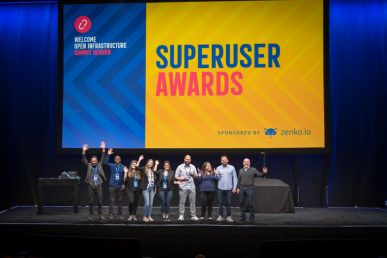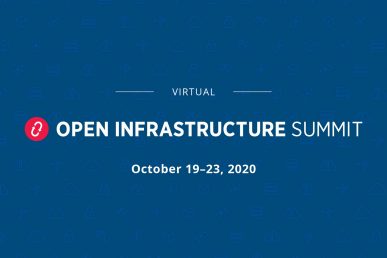At the upcoming Summit Berlin, you’ll find a large contingent of open-source projects meeting up to work together. They include Ansible, Ceph, Docker, Kata Containers, Kubernetes, ONAP, OpenStack, Open vSwitch, OPNFV and Zuul. Also check out the open source community track which covers community management, diversity and inclusion, mentoring, open source governance, ambassadors and roadmap development.
Here are a few picks from the packed schedule of 200 sessions plus workshops:
Kubernetes Administration 101: From zero to hero
You already know Openstack and some Docker but are new to Kubernetes? This daylong hands-on training will teach you the main concepts and daily administration tasks of Kubernetes and boost to your career.
Taught by Laszlo Budai, Component Soft Ltd., it will cover Linux containers and Kubernetes, accessing Kubernetes and access control, workloads, accessing applications, persistent storage. Space is limited, RSVP is required. Details here.
The evolution of Open vSwitch integration for OpenStack
Open vSwitch (OVS) has been an important component of the most commonly used networking backend for OpenStack Neutron for several years. Both the OpenStack and Open vSwitch projects have evolved quite a bit. OVN (Open Virtual Network) is a new implementation of virtual networking from Open vSwitch that can be used by OpenStack, but also other projects such as Kubernetes.
This session with Daniel Alvarez Sanchez and Numan Siddique of Red Hat walks through the journey of OpenvSwitch in OpenStack and covers the latest state of the OVN integration with OpenStack. We will discuss how OVN differs from the original OVS and OpenStack integration, as well as how to migrate an existing deployment to OVN. Details here.
Zuul at BMW: Large scale automotive software development
Since the introduction of software in cars, the complexity of automotive software is constantly rising. BMW manages parts of that complexity with Continuous Integration (CI) systems by automating all stages of the software lifecycle. But some huge software projects, like autonomous driving, start to be limited by the performance of available CI solutions.Tobias Henkel will give an overview of the CI requirements for software projects at BMW and how the automaker uses Zuul to develop software at large scale. Details here.
Open source orchestrators for NFV – What’s going on?
There are so many orchestrators, that operators wonder whether it makes sense to build one or choose from competing models including ONAP, OSM, OPNFV, Tacker, TOSCA, YAML and NETCONF.In the rapidly changing landscape of Open Source orchestration for NFV, it’s easy to get confused about which project is focused on what, what are that communities strengths, weaknesses and key areas of focus.
Join Vanessa Little, Layer123 NFV Advisory Panel, committee member, for an interactive session that offers a clear-eyed view on what’s out there and where these projects are headed. Details here.
Artificial intelligence-based container monitoring, healing and optimizing
Monitoring container ecosystem becomes critical in terms of large business applications with complex use cases, making it challenging for the human brains to troubleshoot problems. Though there are traditional monitoring tools available for containers, recurring problems caused by business use case flow cannot be monitored or healed in traditional Docker monitoring systems.
With the help of AI, containers can be monitored in a way where operations can inject rules depending on their use case and help save sapiens from troubleshooting. Moreover, AI provides flexibility for use-case architects to define their commonly known problems in a Docker environment and define rules accordingly to mitigate them dynamically by better prediction algorithms and gradually optimizing the containers in the long run.
This presentation from Cisco’s Sreekrishna Senthilkumar, Aman Sinha and Sachin Joshi offers knowledge about making use of the benefits of AI in container ecosystem in solving business aspects of container monitoring and healing. Details here.
Spectre/Meltdown at eBay Classifieds Group: Rebooting 80,000 cores
eBay Classifieds Group has a private cloud distributed in two geographical regions (plans for a tertiary zone), around 1,000 hypervisors and a capacity of 80,000 cores.
After Spectre and Meltdown, the team needed to patch hypervisors on four availability zones for each region with the latest kernel, KVM version and BIOS updates. During these updates the zones were unavailable and all the instances restarted automatically. The entire process was automated using Ansible playbooks created internally and using the Openstack API to leverage the operations.
Bruno Bompastor and Adrian Joian will walk attendees through all the work done to shut down, update and boot successfully an infrastructure fully patched and without data loss. They’ll also go into the Openstack challenges, missing features and workarounds. The pair will also discuss the management of our SDN (Juniper Contrail) and LBaaS (Avi Networks) when restarting this massive amount of cores. Details here.
// CC BY NC
- Exploring the Open Infrastructure Blueprint: Huawei Dual Engine - September 25, 2024
- Open Infrastructure Blueprint: Atmosphere Deep Dive - September 18, 2024
- Datacomm’s Success Story: Launching A New Data Center Seamlessly With FishOS - September 12, 2024

)










